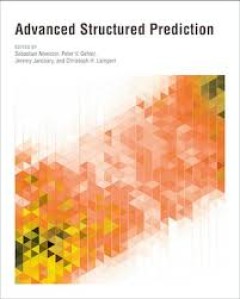Filter by

Advanced Structured Prediction
The goal of structured prediction is to build machine learning models that predict relational information that itself has structure, such as being composed of multiple interrelated parts. These models, which reflect prior knowledge, task-specific relations, and constraints, are used in fields including computer vision, speech recognition, natural language processing, and computational biology. …
- Edition
- -
- ISBN/ISSN
- 0262322951
- Collation
- 1 online resource (ix, 415 pages) :illustrations.
- Series Title
- -
- Call Number
- -

Predicting structured data
Collected papers based on talks presented at two Neural Information Processing Systems workshops.State-of-the-art algorithms and theory in a novel domain of machine learning, prediction when the output has structure.Machine learning develops intelligent computer systems that are able to generalize from previously seen examples. A new domain of machine learning, in which the prediction must sati…
- Edition
- -
- ISBN/ISSN
- 9780262255691
- Collation
- 1 online resource (viii, 348 pages) :illustrations.
- Series Title
- -
- Call Number
- -

Large-scale kernel machines
Pervasive and networked computers have dramatically reduced the cost of collecting and distributing large datasets. In this context, machine learning algorithms that scale poorly could simply become irrelevant. We need learning algorithms that scale linearly with the volume of the data while maintaining enough statistical efficiency to outperform algorithms that simply process a random subset o…
- Edition
- -
- ISBN/ISSN
- 0262255790
- Collation
- 1 online resource (xii, 396 pages) :illustrations.
- Series Title
- -
- Call Number
- -

Open Data Structures
Offered as an introduction to the field of data structures and algorithms, Open Data Structures covers the implementation and analysis of data structures for sequences (lists), queues, priority queues, unordered dictionaries, ordered dictionaries and graphs. Focusing on a mathematically rigorous approach that is fast, practical and efficient, Morin clearly and briskly presents instruction along…
- Edition
- -
- ISBN/ISSN
- -
- Collation
- -
- Series Title
- -
- Call Number
- -
 Computer Science, Information & General Works
Computer Science, Information & General Works  Philosophy & Psychology
Philosophy & Psychology  Religion
Religion  Social Sciences
Social Sciences  Language
Language  Pure Science
Pure Science  Applied Sciences
Applied Sciences  Art & Recreation
Art & Recreation  Literature
Literature  History & Geography
History & Geography